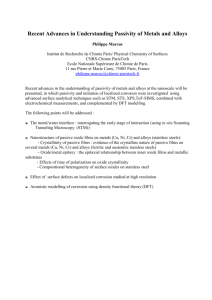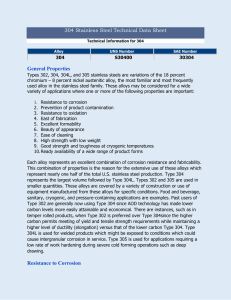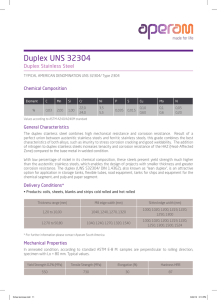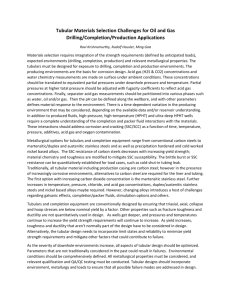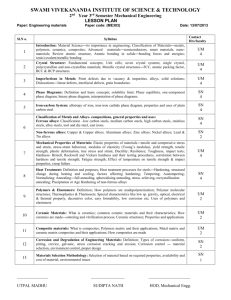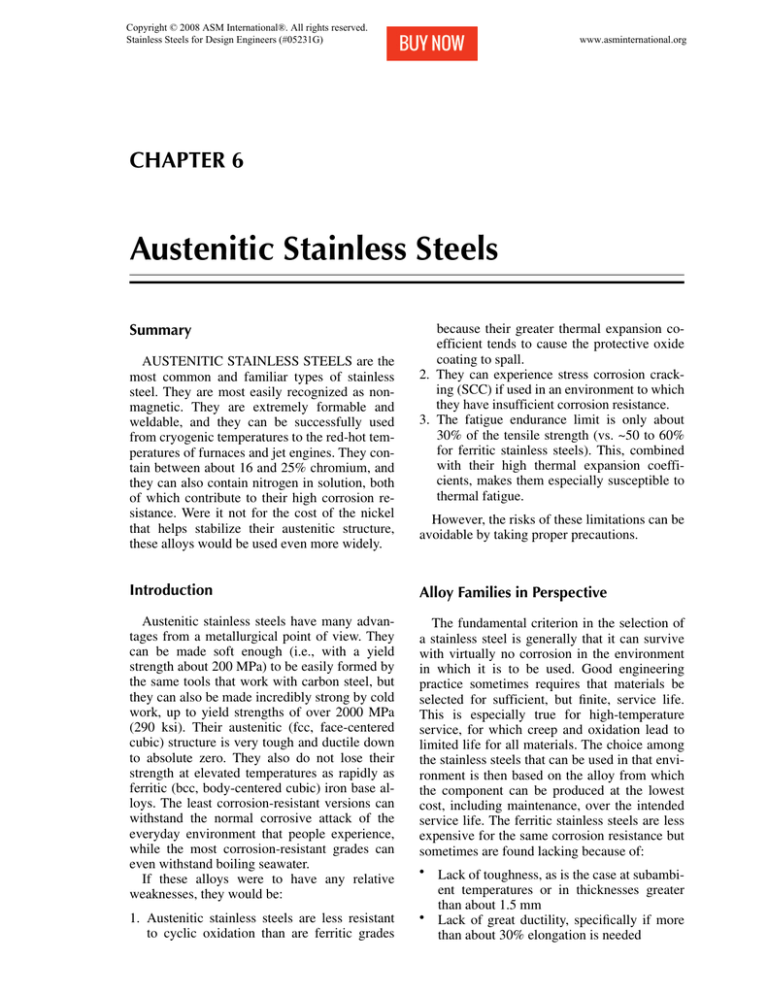
Copyright © 2008 ASM International®. All rights reserved.
Stainless Steels for Design Engineers (#05231G)
www.asminternational.org
CHAPTER 6
Austenitic Stainless Steels
Summary
AUSTENITIC STAINLESS STEELS are the
most common and familiar types of stainless
steel. They are most easily recognized as nonmagnetic. They are extremely formable and
weldable, and they can be successfully used
from cryogenic temperatures to the red-hot temperatures of furnaces and jet engines. They contain between about 16 and 25% chromium, and
they can also contain nitrogen in solution, both
of which contribute to their high corrosion resistance. Were it not for the cost of the nickel
that helps stabilize their austenitic structure,
these alloys would be used even more widely.
because their greater thermal expansion coefficient tends to cause the protective oxide
coating to spall.
2. They can experience stress corrosion cracking (SCC) if used in an environment to which
they have insufficient corrosion resistance.
3. The fatigue endurance limit is only about
30% of the tensile strength (vs. ~50 to 60%
for ferritic stainless steels). This, combined
with their high thermal expansion coefficients, makes them especially susceptible to
thermal fatigue.
However, the risks of these limitations can be
avoidable by taking proper precautions.
Introduction
Alloy Families in Perspective
Austenitic stainless steels have many advantages from a metallurgical point of view. They
can be made soft enough (i.e., with a yield
strength about 200 MPa) to be easily formed by
the same tools that work with carbon steel, but
they can also be made incredibly strong by cold
work, up to yield strengths of over 2000 MPa
(290 ksi). Their austenitic (fcc, face-centered
cubic) structure is very tough and ductile down
to absolute zero. They also do not lose their
strength at elevated temperatures as rapidly as
ferritic (bcc, body-centered cubic) iron base alloys. The least corrosion-resistant versions can
withstand the normal corrosive attack of the
everyday environment that people experience,
while the most corrosion-resistant grades can
even withstand boiling seawater.
If these alloys were to have any relative
weaknesses, they would be:
The fundamental criterion in the selection of
a stainless steel is generally that it can survive
with virtually no corrosion in the environment
in which it is to be used. Good engineering
practice sometimes requires that materials be
selected for sufficient, but finite, service life.
This is especially true for high-temperature
service, for which creep and oxidation lead to
limited life for all materials. The choice among
the stainless steels that can be used in that environment is then based on the alloy from which
the component can be produced at the lowest
cost, including maintenance, over the intended
service life. The ferritic stainless steels are less
expensive for the same corrosion resistance but
sometimes are found lacking because of:
• Lack of toughness, as is the case at subambient temperatures or in thicknesses greater
than about 1.5 mm
• Lack of great ductility, specifically if more
than about 30% elongation is needed
1. Austenitic stainless steels are less resistant
to cyclic oxidation than are ferritic grades
70 / Stainless Steels for Design Engineers
• Susceptibility to high-temperature embrittling phases when moderately alloyed
The less-expensive martensitic grades are
used instead of austenitic when high strength
and hardness are better achieved by heat treating rather than by cold work, and mechanical
properties are more important than corrosion resistance. This is also the case for the more expensive PH grades, which can achieve corrosion
resistance only matching the least corrosion resistant of the austenitic alloys.
Duplex grades match austenitic grades in corrosion resistance and have higher strength in the
annealed condition but present the designer
with challenges with regard to embrittling
phases that can form with prolonged exposure
to elevated temperatures and only moderate
ductility like the ferritic alloys.
So, the austenitic grades are the most commonly used grades of stainless mainly because,
in many instances, they provide very predictable
levels of corrosion resistance with excellent mechanical properties. Using them wisely can save
the design engineer significant costs in his or her
product. They are a user-friendly metal alloy
with life-cycle cost of fully manufactured products lower than many other materials.
Fig. 1
The austenitic alloys can have compositions
anywhere in the portion of the Delong diagram
labeled austenite shown in Fig. 1 (Ref 1). This
diagram was designed to show which phases are
present in alloys in the as-solidified condition,
such as found in welds. Thus it also applies to
castings and continuously cast products. As a
practical matter of castability, the composition
of most commercial alloys falls along the zone
of several percent ferrite as cast. The salient feature of austenitic alloys is that as chromium and
molybdenum are increased to increase specific
properties, usually corrosion resistance, nickel
or other austenite stabilizers must be added if
the austenitic structure is to be preserved.
The traditional way of displaying the
austenitic stainless steels is to present 302 as a
base. Figure 2 shows one such diagram. Diagrams such as these treat alloys as an evolutionary family tree and subtly mislead. Many alloys
were pushed toward obsolescence because of
advances in processing. For instance, 321 was
developed as an alloy in which the detrimental
effects of carbon were negated by addition of titanium. The widespread adoption of the argon
oxygen decarburization (AOD) in the 1970s
made this alloy unnecessary, except for special
circumstances, since carbon could be cheaply
Schaeffler-Delong stainless steels constitution diagram. Adapted from Ref 1, 2
Chapter 6: Austenitic Stainless Steels / 71
Fig. 2
The austenitic stainless family. Source: Ref 3
removed routinely. Likewise, 302 gave way to
the lower-carbon 304, for which the even lowercarbon 304L is commonly substituted and dually certified to qualify as either grade. While
low carbon prevents sensitization, stabilized
grades may still be preferred for special applications such as type 321 in aerospace and type
347 in refinery service. Similar inertia keeps the
higher-nickel 300 series as the de facto standard
when the more cost-efficient high-manganese
200 series is the logical basic grade. The relevant types of austenitic alloys can nonetheless
be rationalized with this diagram.
As chromium is added, oxidation resistance
and corrosion resistance increase. Because
nickel equivalents (manganese, nitrogen, carbon,
etc.) must also be added in matching amounts,
austenite stability is also increased. If molybdenum, a chromium equivalent, is added, corrosion resistance but not oxidation resistance is
enhanced. And, if nitrogen is the austenite stabilizer added to balance increases chromium or
molybdenum, then corrosion resistance is also
increased. With small exceptions, that is the
rationale of austenitic grade design. Silicon
is used as an alloy to promote oxidation resistance and resistance to corrosion by oxidizing
acids. Copper is used to promote resistance to
sulfuric acid. Rare earths make a more stably
oxidation-resisting scale. Niobium increases
72 / Stainless Steels for Design Engineers
creep resistance. Sulfur and selenium increase
machinability.
In this chapter, austenitic alloys are classified
into three groups:
• Lean alloys, such as 201 and 301, are generally used when high strength or high formability is the main objective since the lower,
yet tailorable, austenite stability of these alloys gives a great range of work-hardening
rates and great ductility. Richer alloys, such
as 305, with minimal work hardening are the
high-alloy, lowest work-hardening rate
grade for this purpose. The general-purpose
alloy 304 is within this group.
• Chromium nickel alloys when the objective
is high temperature oxidation resistance.
This can be enhanced by silicon and rare
earths. If the application requires high-temperature strength, carbon, nitrogen, niobium,
and molybdenum can be added. 302B, 309,
310, 347, and various proprietary alloys are
found in this group.
• Chromium, molybdenum, nickel, and nitrogen alloys when corrosion resistance is the
main objective. Alloys such as silicon and
copper are added for resistance to specific
environments. This group includes 316L,
317L, 904L, and many proprietary grades.
Lean Alloys
Lean austenitic alloys constitute the largest
portion of all stainless steel produced. These are
principally 201, 301, and 304. Alloys with less
than 20% chromium and 14% nickel fall into
this unofficial category. Since they are stainless,
it is generally taken for granted that these alloys
will not corrode, and these alloys have sufficient corrosion resistance to be used in any indoor or outdoor environment, excluding coastal.
These grades are easily weldable and formable
and can be given many attractive and useful surface finishes, so they are very much generalpurpose alloys. Table 1 lists some typical compositions of the most commonly used lean
austenitic alloys. These typical compositions
vary with end use, raw material cost factors, and
the preference of a given manufacturer. The
compositions of standard alloys are often finetuned to the intended end use. In this table, the
word drawing indicates higher nickel for lower
work hardening, while tubing indicates alloys
with higher sulfur to facilitate gas tungsten arc
welding (GTAW) penetration. Tensile indicates
lower alloy levels to increase the work-hardening rate for material that is intended to be used
in the cold-worked, high-strength condition.
316L is included in its most common tubing end
use chemistry even though it is a corrosion-resisting alloy because it is so pervasively used as
a service center sheet item.
The main difference among the lean
austenitic alloys lies in their work-hardening
rate: the leaner the alloy, the lower the austenite
stability. As unstable alloys are deformed, they
transform from austenite to the much harder
martensite. This increases the work-hardening
rate and enhances ductility since it delays the
onset of necking since greater localized
Wrought alloys generally have cast counterparts that differ primarily in silicon content.
Versions that require enhanced machinability
have a high content of controlled inclusions,
sulfides, or oxysulfides, which improve machinability at the expense of corrosion resistance.
Carbon is kept below 0.03% and designated an
L grade when prolonged heating due to multipass welding of heavy section (greater than
about 2 mm) or when welds requiring a postweld stress relief are anticipated.
Table 1 Typical compositions of the most commonly used lean austenitic alloys
Alloy
Designation
C
N
Cr
Ni
Mo
Mn
Si
Other
Other
Other
201
201 drawing
201LN
301 tensile
301 drawing
303
304
304 drawing
304 extra drawing
304L tubing
305
321
316L
S20100
S220100
S20153
S30100
S30100
S30300
S30400
S30400
S30400
S30403
S30500
S32100
S31603
0.08
0.08
0.02
0.08
0.08
...
0.05
0.05
0.06
0.02
0.05
0.05
0.02
0.07
0.07
0.13
0.4
0.04
...
0.05
0.04
0.04
0.09
0.02
0.01
0.0
16.3
16.9
16.3
16.6
17.4
...
18.3
18.4
18.3
18.3
18.8
17.7
16.4
4.5
5.4
4.5
6.8
7.4
...
8.1
8.6
9.1
8.1
12.1
9.1
10.5
0.2
0.02
0.2
0.2
0.02
...
0.3
0.3
0.3
0.3
0.2
0.03
2.1
7.1
7.1
7.1
1.0
1.7
...
1.8
1.8
1.8
1.8
0.8
1.0
1.8
0.45
0.5
0.45
0.45
0.45
...
0.45
0.45
0.45
0.45
0.60
0.45
0.50
0.001 S
0.001 S
0.001 S
0.001 S
0.007 S
...
0.001 S
0.001 S
0.001 S
0.013 S
0.001 S
0.001 S
0.010 S
0.03 P
0.30 P
0.03 P
0.03 P
0.03 P
...
0.03 P
0.03 P
0.030 P
0.030 P
0.02 P
0.03 P
0.03 P
0.2 Cu
0.6 Cu
0.5 Cu
0.3 Cu
0.6 Cu
...
0.3 Cu
0.3 Cu
0.4 Cu
0.4 Ci
0.2 Cu
0.4 Ti
0.4 Cu
Chapter 6: Austenitic Stainless Steels / 73
deformation is more than offset by greater localized strain hardening.
These grades are best viewed as a continuum
with a lower boundary at 16%Cr-6%Ni and an
upper boundary at 19%Cr-12%Ni. This represents the range from minimum to maximum
austenite stability. Since that is the main distinction within this grade family, let us examine its
basis.
Martensite and Austenite. Stability. The
formation of martensite at room temperature
may be thermodynamically possible, but the
driving force for its formation may be insufficient for it to form spontaneously. However,
since martensite forms from unstable austenite
by a diffusionless shear mechanism, it can occur
if that shear is provided mechanically by external forces. This happens during deformation,
and the degree to which it occurs varies with
composition according to (Ref 4):
such as occurs when they are sensitized or when
solute segregation occurs, as from welding, then
the equation applies on a microscopic scale.
Sensitized zones (i.e., the regions near grain
boundaries where chromium carbides have precipitated) will have a much higher tendency to
transform to martensite. Figures 3(a) and (b)
show the changes in phase structure as a function of composition over ranges that encompass
these alloys.
Martensite can be present in two different
forms. The α′-form is the bcc magnetic form,
while ε is a nonmagnetic, hcp (hexagonal closepacked) version. The formation of ε versus α′ is
related to the stacking fault energy of the alloy,
which is given by (Ref 6):
Md30 (°C) = 551 – 462(%C + %N)
– 9.2(%Si) – 8.1(%Mn) – 13.7(%Cr)
– 29(%Ni + Cu) – 18.5(%Mo)
– 68(%Nb) – 1.42 (GS – 8)
(Eq 1)
Y300SF (mJ m-2) = Y0SF + 1.59Ni – 1.34Mn
+ 0.06Mn2 – 1.75Cr + 0.01Cr2
+ 15.21Mo – 5.59Si
–60.69(C + 1.2N)1/2
+ 26.27(C + 1.2N)
(Cr + Mn + Mo)1/2
+ 0.61[Ni•(Cr + Mn)]1/2
(Eq 2)
This is the temperature at which 50% of the
austenite transforms to martensite with 30%
true strain (Ref 5). It should be noted that even
elements that are chromium equivalents in promoting ferrite are austenite stabilizers in that
they impede martensite formation. This temperature is the common index of austenite stability.
This regression analysis was generated for homogeneous alloys. If alloys are inhomogeneous,
Epsilon martensite formation is favored in
alloys of lower stacking fault energy. The fcc
structures deform by slip between (111)
planes. Viewed from these planes, the structure
is a series of ABCABC atom arrangements.
Slip between planes can result in an
ABCA/CAB structure. This so-called stacking
fault generates an hcp structure. With lower
stacking fault energies, these are more readily
Fig. 3
(a) Iron-chromium phase diagram at 8% nickel; (b) iron-nickel phase diagram at 18% chromium
74 / Stainless Steels for Design Engineers
Fig. 4
Variation of martensite formation with temperature and true strain for 304. Source: Ref 7
formed, and ε predominates. The stacking fault
can also be viewed as two partial dislocations
with the material between them faulted. These
partial dislocations, when generated in abundance, cannot readily slip past one another
and thus pile up, increasing work-hardening
rates.
As in carbon and alloy steels, the martensite
transformation can take place simply by cooling, but in the lean austenitic alloys the temperatures are well below ambient. The more stable
alloys do not transform even with cryogenic
treatment. Figure 4 shows the variation of
martensite formation with temperature and true
strain for 304. Martensite formed in these alloys
is quite stable and does not revert until heated
well above the temperatures (Fig. 5) at which it
was formed. The carbon levels of austenitic
stainless steels are always relatively low, so
strain-induced martensite is self-tempering and
not brittle.
Martensite has been found to form in unstable
austenite due to the electrochemically induced
supersaturation by hydrogen (Ref 9). Under
conditions of cathodic charging, superficial layers were found to transform to ε under conditions of intense hydrostatic compression. During subsequent outgassing, α′ was found to
form due to reversals in the stress state. Martensite thus formed is, of course, susceptible to
hydrogen embrittlement.
Mechanical Properties. The tensile properties in the annealed state not surprisingly relate
well to composition. The 0.2% yield strength
and tensile strength, respectively, are reported
(Ref 10) to follow the equations:
YS( MPa) = 15.4[4.4 + 23(%C) + 32(%N)
+ 0.24(%Cr ) + 0.94(%Mo)
+ 1.3(%Si ) + 1.2(%V)
+ 0.29(%W ) + 2.6(%Nb)
+ 1.7(%Ti ) + 0.82(%Al )
+ 0.16(%Ferrite )
+ 0.46(d −1/1/ 2 )
(Eq 3)
TS ( MPa) = 15.4[29 + 35(%C) + 55(%N)
+ 2.4(%Si ) + 0.11((%Ni ) + 1.2(%Mo)
+ 5.0(%Nb) + 3.0(%Ti ) + 1.2(%Al )
+ 0.14(%Ferrite ) + 0.82(d −1/ 2 )
(Eq 4)
In each case, d is the grain diameter in millimeters.
Another researcher (Ref 11) gave the relationships as:
YS ( MPa ) = 120 + 210 N + 0.02 + 2 Mn + 2Cr
+ 14 Mo + 10 Cu + (6.15 − 0.054δ)δ
+ (7 + 35(N + 0.2))d −1/ 2
(Eq 5)
TS = 470 + 600( N + 0.2)
+ 14 Mo + 1.5δ + 8d −1/ 2
(Eq 6)
Again, d is grain diameter in millimeters, and
δ is percent ferrite. The claimed accuracy for
the latter set of equations is 20 MPa and is said
Chapter 6: Austenitic Stainless Steels / 75
Fig. 6
Fig. 5
Reversion of martensite formed by cold work. Source:
Ref 8
to apply to both austenitics and duplex stainless
steels, but clearly the tensile strength relationship must break down for leaner alloys, such as
301, in which tensile strength increases with decreasing alloy content because of the effect of
increasing alloying causing less transformation
to martensite, which inarguably produces higher
tensile strengths in austenitic stainless steels.
Equation 3 must also be favored over Eq 5 in
that it accounts for carbon explicitly.
One other hardening mechanism is possible
in austenitic stainless steels, and that is precipitation hardening. Most precipitation-hardening
stainless steels are unstable austenite, which is
transformed to martensite before the precipitation hardening takes place. One commercial
alloy, A-286, is entirely austenitic and employs
the precipitation within the austenite matrix of
Ni3 (titanium, aluminum) for strengthening.
This is dealt with in a separate section.
Austenitic stainless steels do not have a clear
yield point but can begin to deform at as little as
40% of the yield strength. As a rule of thumb,
behavior at less than half the yield strength is
considered fully elastic and stresses below twothirds of the yield strength produce negligible
plastic deformation. This quasi-elastic behavior
is a consequence of the many active slip systems in the fcc structure. Even highly coldworked material exhibits this phenomenon, although stress-relieving cold-worked material
will cause dislocations to “lock in place” and
Variation of impact strength with temperature for (a)
austenitic, (b) duplex, and (c) ferritic stainless steels
form more stable dislocation arrays that break
loose at a higher and distinct yield point.
The tensile properties of austenitic stainless
steels with unstable austenite, that is, those with
Md30 temperatures (Eq 1) near room temperature, are very strain rate dependent. This is simply due to the influence of adiabatic heating
during testing increasing the stability of the
austenite. Tests run under constant temperature
conditions, either by slow strain rates or use of
heat sinks, produce lower tensile strengths.
Thus, reported tensile strengths should not be
taken as an absolute value but a result that can
be significantly changed by changes in testing
procedure, even with accepted norms and
standards.
Highly cold-worked austenitic stainless
steels are often used for their robust mechanical
properties. Few metallic materials can match
the very high strengths they can achieve. Very
lean 301 can be cold worked to yield strengths
on the order of 2000 MPa because of its unstable austenite transforming to martensite. When
cold worked to lower degrees, it can provide
very high strength while keeping impressive
ductility.
Austenitic stainless steels have exceptional
toughness. The ambient temperature impact
strength of austenitic stainless steels is quite
high. This is not surprising in view of their high
tensile strengths and high elongations. What is
most remarkable is the absence of a transition
temperature, which characterizes ferritic and
martensitic materials. Figure 6 shows impact
strength of the various stainless steel types versus temperature. This again is due to the multiplicity of slip systems in the fcc structure and
the fact that they do not require thermal activation. This makes the austenitic stainless steels,
especially the 200 series, the optimal cryogenic
76 / Stainless Steels for Design Engineers
material, surpassing the 9% nickel martensitic
steels in cost, toughness, and, of course, corrosion resistance.
Precipitation of Carbides and Nitrides.
Carbon is normally considered as an undesirable impurity in austenitic stainless steel. While
it stabilizes the austenite structure, it has a great
thermodynamic affinity for chromium. Because
of this affinity, chromium carbides, M23C6, form
whenever carbon reaches levels of supersatura-
tion in austenite, and diffusion rates are sufficient for carbon and chromium to segregate into
precipitates. The solubility of carbon in austenite is over 0.4% at solidification but decreases
greatly with decreasing temperature. The solubility is given by (Ref 12):
log (C ppm ) = 7771 −
6272
T (°K )
(Eq 7)
The equilibrium diagram for carbon in a basic
18%Cr10%Ni alloy is shown in Fig. 7. At room
temperature, very little carbon is soluble in
austenite; even the 0.03% of L grades is mostly
in a supersaturated solution. The absence of carbides in austenitic stainless is due to the slow
diffusion of carbon and the even slower diffusion of chromium in austenite. At a carbon level
of 0.06%, which is found in most 304, supersaturation is reached below about 850 °C. Below
this temperature, supersaturation increases exponentially, while diffusion decreases exponentially. This results in precipitation rates that vary
with temperature and carbon level as shown in
Fig. 8. At these temperatures, grain boundary
diffusion is much more rapid than bulk diffusion, and grain boundaries provide excellent nucleation sites, so precipitation occurs along
grain boundaries. And, because carbon diffuses
several orders of magnitude more rapidly than
chromium, carbon diffuses to and combines
with chromium essentially in situ, depleting the
grain boundaries of chromium in solution.
Fig. 7
Carbon solubility in 18–10 austenitic stainless. Source:
Ref 13
Fig. 8
The precipitation rates for Cr23C6 as a function of carbon content
Chapter 6: Austenitic Stainless Steels / 77
Fig. 10
Fig. 9
Depletion of chromium from the austenite near grain
boundaries due to chromium carbide precipitation.
Source: Ref 14
Figure 9 shows that the local chromium depletion is such that the chromium level can become low enough that it has not even enough to
be stainless and certainly much lower corrosion
resistance than the surrounding area. This zone,
because it is lower in chromium, also has very
unstable austenite and is quite prone to martensite formation. Figure 10 shows how the locus
of precipitation changes with time and temperature. Carbon relatively far from grain boundaries in the interior of grains remains in supersaturation until much longer times and much
greater supersaturation since bulk diffusion is
required for the nucleation and growth of these
precipitates.
The key observation is that any solid-state
precipitation of a chromium-rich precipitate
will necessarily cause local chromium depletion
and a resulting loss of corrosion resistance.
Variation of carbide precipitation locus with time.
Source: Ref 16
Much longer term heat treatment is required to
eliminate these depleted zones by rehomogenization of slowly diffusing chromium than the
short time required to form them. This is very
evident for carbides, but also true for oxides.
Underneath chromium-rich oxide scales is a
layer depleted in chromium and lower in corrosion resistance. This is why not only scale from
welding must be removed, but also the underlying chromium-depleted zone.
Other precipitation processes that give rise to
chromium depletion are α and χ and the solidstate precipitation of oxides, nitrides, and sulfides. Chromium precipitates that form in the
liquid alloy do not cause depletion of chromium
locally because no chromium gradients are set
up around them during precipitation as diffusion in the liquid is very rapid. Thus, primary
carbides, oxides, and sulfides are not per se
harmful to corrosion resistance. But, if the same
compounds form and grow in the solid state,
chromium depletion occurs (Ref 15).
Alloying elements can have a major influence
on carbide precipitation by their influence on the
solubility of carbon in austenite. Molybdenum
and nickel accelerate the precipitation by diminishing the solubility of carbon. Chromium and
nitrogen increase the solubility of carbon and
thus retard and diminish precipitation. Nitrogen
is especially useful in this regard (Fig. 11).
Increasing austenite grain size accelerates
precipitation, as does cold work, especially in
the interior of grains, where diffusion is enhanced by increased defect density.
Nitrogen is much more soluble than carbon
and does not give rise to sensitization phenomena as does carbon even though Cr2N can be a
78 / Stainless Steels for Design Engineers
Fig. 11
Delay in carbide precipitation induced by nitrogen
level. Source: Ref 17
stable phase when the solubility limit is exceeded. The solubility is over 0.15% in austenite, so its precipitation seldom has the possibility of occurring, but it does become an issue in
ferritic stainless steels in this regard, for which
solubility is much lower. Manganese and
chromium increase the solubility of nitrogen in
austenite.
Stabilization. Before carbon was easily lowered to harmless levels, it was found that adding
more powerful carbide formers than chromium
could preclude the precipitation of chromium
carbides. Titanium and niobium are the most
useful elements in this regard. They form carbides with solubility that follows the following
equation type:
log [ M] [ X] = + A − H
RT
(Eq 8)
For titanium carbide and niobium carbide, the
respective solubilities are:
log [Ti ] [C] = 2.97 −
6780
T
log [ Nb] [C] = 4.55 −
9350
T
(Eq 9)
(Eq 10)
Oxides and sulfides are more energetically favorable than are carbides and nitrides of these
metals. Thus, any additions made to form carbides must be sufficient to account for the prior
formation of these compounds. Nitrogen also
competes with carbon for available titanium or
niobium. Thus, for successful gettering of all
carbon, there must be sufficient titanium or niobium to combine stoichiometrically with all
these species present.
This requires in rough terms that titanium exceed four times the carbon plus nitrogen, or that
niobium exceed eight times, after accounting
for the oxygen and sulfur. It would be a mistake
Fig. 12
Variation of hardness with depth and therefore carbon content in colossal supersaturation
to ignore the titanium-consuming capacity of
oxygen and sulfur unless they have been minimized by refining, which can be done quite
readily.
Even if sufficient titanium or niobium is present to combine with all carbon, kinetic considerations may result in that not occurring. High
temperatures, such as encountered in welding,
dissociate carbides. If quenched from this state,
carbon can be free to form Cr23C6 if it is reheated to temperatures above 500 °C.
Carbon has always been considered totally
undesirable from a corrosion point of view because of its tendency to form chromium carbides. Recently, however, new processes have
been developed to supersaturate carbon in
austenite below the temperatures at which it has
sufficient mobility to form carbides. This socalled colossally supersaturated austenite results in very high hardness (Fig. 12) and corrosion resistance over limited depths. From this,
however, we can see that carbon, like nitrogen,
is actually beneficial to corrosion resistance in
solid solution, although this is not observed at
normal concentrations. It is possible to see that
if it could be kept in solution it would be appropriate to give it a factor of around 10 in the pitting resistance equivalent number (PREN)
equation:
PREN = %Cr + 3.3(%Mo)
+ 30(%N) + 10(%C)
(Eq 11)
This is consistent with the similar thermodynamic interaction coefficients that carbon and
nitrogen share with regard to chromium.

